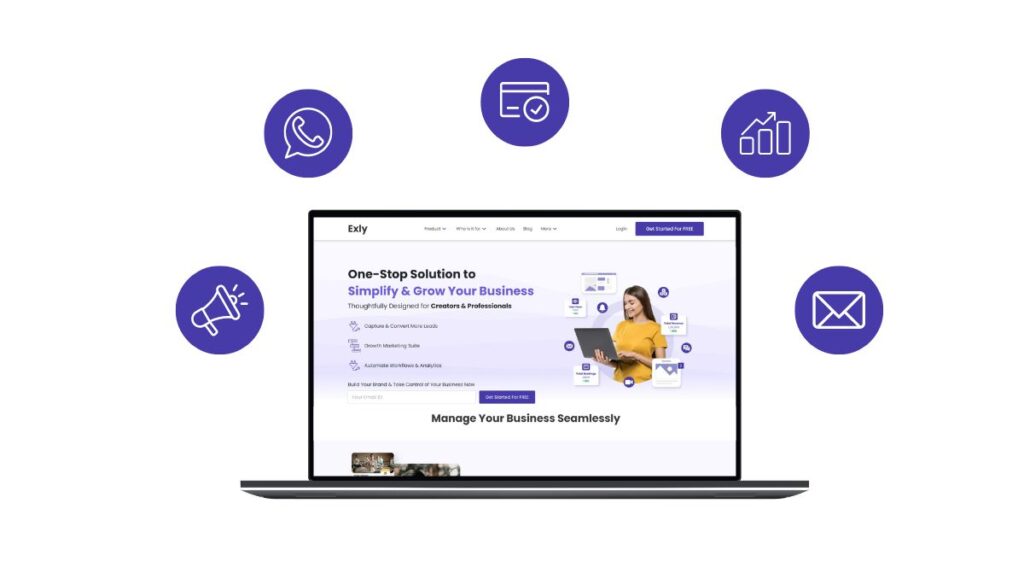Business automation involves the use of technology to streamline business processes and automate repetitive tasks. This includes automating workflows, data entry, communication, and other routine tasks. By automating these tasks, creators can save time and resources, reduce errors, and improve productivity. There are several benefits to business automation, which we will explore in this article.
Benefits of Business Automation for Creators

Creators can benefit from business automation in a number of ways. By automating routine tasks, creators can focus on their creative work, while technology takes care of administrative tasks. Some of the key benefits of business automation for creators include:
- Increased productivity: Automation can help streamline workflows, reduce errors, and speed up tasks, leading to increased productivity.
- Time savings: Automation frees up time that can be used for more creative work, building relationships with customers, and other high-value activities.
- Cost savings: Automating routine tasks can reduce the need for manual labor, leading to cost savings for the business.
- Improved accuracy: Automation can reduce errors and improve accuracy in tasks such as data entry and record-keeping.
- Scalability: Automation can help businesses scale their operations without the need for additional resources.
Common Business Automation Tools
There are a variety of tools and software available for business automation. Some of the most common tools include:
- Customer relationship management (CRM) software: CRM software helps businesses manage customer interactions and automate tasks such as email marketing, lead management, and customer support.
- Accounting software: Accounting software can automate tasks such as invoicing, billing, and financial reporting.
- Marketing automation software: Marketing automation software can automate tasks such as social media posting, email marketing, and lead generation.
- Project management software: Project management software can automate tasks such as task assignments, scheduling, and collaboration.
- Workflow automation software: Workflow automation software can automate repetitive tasks such as data entry, file management, and document processing.
Business Automation Examples for Creators
Here are a few examples of business automation in action for creators:
- Email marketing automation: Creators can use email marketing software to automate the process of sending newsletters, promotional emails, and other marketing messages to their subscribers.
- Social media automation: Creators can use social media automation tools to schedule posts, track engagement, and analyse performance.
- Content creation automation: Creators can use tools such as Grammarly or Hemingway Editor to automate the process of editing and proofreading their written content.
- Task automation: Creators can use workflow automation tools such as Zapier or IFTTT to automate repetitive tasks such as data entry, file management, and document processing.
How to Automate Your Workflow
Here are some steps you can take to automate your workflow:
- Identify the tasks that can be automated: Look for repetitive tasks that take up a lot of time and could be automated.
- Choose the right automation tools: Choose tools that are compatible with your business and can automate the tasks you’ve identified.
- Create a workflow: Create a workflow that outlines how tasks will be automated and who will be responsible for managing them.
- Test your automation: Test your automation to ensure it’s working as intended and making your workflow more efficient.
Choosing the Right Automation Tools
When choosing automation tools, consider the following factors:
- Compatibility: Ensure the tools you choose are compatible with your existing technology stack.
- Functionality: Choose tools that have the functionality you need to automate your workflows.
- Ease of use: Choose tools that are easy to set up and use, so you can start automating tasks quickly.
- Cost: Consider the cost of the tools and whether they provide enough value to justify the investment.
Key considerations when implementing business automation:
- Clearly define the business processes that can be automated: Before implementing automation, it is essential to identify the processes that can be automated. It’s important to evaluate the processes’ complexity, frequency, and impact on the business.
- Choose the right automation tool: There are different automation tools available in the market. It is essential to choose the tool that best suits the business’s requirements and is compatible with existing IT infrastructure.
- Involve stakeholders: Involving all stakeholders, including employees, management, and IT personnel, in the automation process can help gain their buy-in and support.
- Develop a comprehensive plan: It is essential to develop a detailed plan that outlines the automation process, timelines, roles and responsibilities, and expected outcomes.
- Provide training: Automation can require new skills and processes. Providing training to employees can help ensure a smooth transition to the new system.
Business automation best practices:
- Start small: Begin by automating one or two processes and then gradually expand to more complex processes.
- Focus on measurable outcomes: Set clear objectives and KPIs to measure the automation’s success and continuously monitor and evaluate the results.
- Use standardisation and simplification: Standardising processes and simplifying procedures can help optimise the automation’s benefits.
- Ensure data quality: Automation relies heavily on data, and it’s essential to ensure that the data used is accurate and up-to-date.
- Ensure security and compliance: Automation can create vulnerabilities that can compromise security and regulatory compliance. It is essential to ensure that the automation process meets all security and regulatory requirements.
Measuring the success KPIs of business automation:

- Cost savings: Automation can help reduce operational costs by eliminating manual processes, reducing errors, and increasing efficiency.
- Productivity: Automation can increase productivity by reducing manual tasks and freeing up time for more complex work.
- Quality: Automation can improve the quality of output by reducing errors and ensuring consistency.
- Customer satisfaction: Automation can help improve customer satisfaction by reducing response times and improving service quality.
- Revenue growth: Automation can help increase revenue growth by reducing costs, improving efficiency, and enhancing customer satisfaction.
Business Automation Tips for Creators:
The creative industry is a diverse field, and it includes various professionals like artists, designers, writers, filmmakers, and musicians. For creators, business automation can provide numerous benefits, including increased productivity, cost savings, and improved quality. Here are some tips for creators to implement automation in their workflow:
- Identify repetitive tasks: Creators often have to perform repetitive tasks like responding to emails, invoicing, and file organisation. Identifying these tasks can help creators automate them and save time.
- Use automation tools: There are various automation tools available for creators, including project management software, marketing automation software, and accounting software. Using these tools can help creators streamline their workflow and increase efficiency.
- Automate social media: Social media is an essential tool for creators to market their work. However, managing social media accounts can be time-consuming. Automating social media posts using tools like Hootsuite or Buffer can help creators save time and increase their social media presence.
- Use email automation: Email automation can help creators manage their communication with clients and customers. Setting up email templates and automating email responses can help creators save time and increase their productivity.
- Outsource non-creative tasks: Outsourcing non-creative tasks like bookkeeping, website maintenance, and customer support can help creators focus on their creative work.
Examples of Successful Business Automation in the Creative Industry:

Here are some examples of successful business automation in the creative industry:
- Pixar: Pixar, the animation studio, has implemented automation in their production process. They use a proprietary software called “Presto” that automates tasks like colour correction, lighting, and animation. This has helped them increase efficiency and reduce production costs.
- Shutterstock: Shutterstock, the stock photography and video platform, uses machine learning to automate the process of categorising and tagging images. This has helped them improve search accuracy and increase customer satisfaction.
- Spotify: Spotify, the music streaming service, uses automation to personalise their user experience. They use machine learning algorithms to analyse user data and provide personalised recommendations based on their listening habits.
Business Automation vs. Delegation: Which is Better?
Business automation and delegation are both strategies that can help businesses increase efficiency and productivity. However, they have different benefits and drawbacks, and the choice between the two depends on the business’s goals and resources.
Automation is the process of using technology to automate tasks and processes. Automation can help businesses save time and increase efficiency. However, automation requires an initial investment in technology and may not be suitable for all tasks and processes.
Delegation, on the other hand, involves assigning tasks and responsibilities to other employees or outsourcing them to third-party providers. Delegation can help businesses increase their capacity and focus on core competencies. However, delegation requires effective communication and management, and the quality of work may vary depending on the provider’s skill level.
In conclusion, the choice between automation and delegation depends on the business’s goals, resources, and the tasks that need to be performed. A combination of both strategies may be the best approach for some businesses.
The Future of Business Automation for Creators:

The future of business automation for creators is promising. Advancements in technology like artificial intelligence, machine learning, and robotics are providing creators with new opportunities to automate their workflow.
One area where automation is likely to have a significant impact on the creative industry is in content creation. AI-powered tools like Artbreeder and DALL-E are already being used by creators to generate art and design.
Another area where automation can provide benefits is in the music industry. AI-powered tools like Amper Music and AIVA are being used to create original music compositions.
In conclusion, the future of business automation for creators is likely to be characterised by new opportunities for content creation and increased efficiency in workflow management.
Creators can use automation to reduce the time spent on administrative tasks, such as invoicing, email management, and file organisation. This can help them focus more on their creative work and increase productivity.
Another area where automation can provide benefits is in marketing and advertising. AI-powered tools can help creators analyse customer data, identify trends, and create personalised marketing campaigns. This can help creators increase their audience reach and engagement.
However, it is important to note that while automation can provide numerous benefits, it is not a substitute for creativity and human touch. Creators must continue to prioritise their unique creative skills and insights while using automation to enhance their workflow and increase efficiency.
Measuring the Success of Business Automation:

Measuring the success of business automation is essential to ensure that the investment in technology and resources is delivering the desired results. Here are some key metrics that businesses can use to measure the success of business automation:
- Productivity: Measuring the time saved and productivity gains resulting from automation can provide insights into the success of automation. Businesses can compare their current productivity levels to pre-automation levels to determine the impact of automation on productivity.
- Cost savings: Automation can help businesses reduce costs associated with tasks like manual data entry, customer support, and invoicing. Measuring cost savings resulting from automation can provide insights into the success of automation.
- Customer satisfaction: Automation can help businesses improve customer satisfaction by providing faster response times and personalised experiences. Measuring customer satisfaction levels before and after implementing automation can help businesses determine the impact of automation on customer satisfaction.
- Employee satisfaction: Automation can help businesses reduce the time spent on repetitive and mundane tasks, allowing employees to focus more on meaningful work. Measuring employee satisfaction levels before and after implementing automation can provide insights into the impact of automation on employee satisfaction.
Measuring the success of business automation is essential to ensure that businesses are achieving their goals and realising the benefits of automation. Businesses can use a combination of quantitative and qualitative metrics to determine the impact of automation on productivity, cost savings, customer satisfaction, and employee satisfaction.
Conclusion:
Business automation can provide numerous benefits for creators, including increased productivity, cost savings, and improved quality. Implementing automation requires identifying repetitive tasks, using automation tools, outsourcing non-creative tasks, and automating social media and email.
Successful examples of automation in the creative industry include Pixar, Shutterstock, and Spotify. The choice between automation and delegation depends on the business’s goals, resources, and the tasks that need to be performed.
The future of business automation for creators is promising, with opportunities for content creation, marketing, and increased efficiency. Measuring the success of business automation requires tracking productivity gains, cost savings, customer satisfaction, and employee satisfaction.

Overall, automation can help creators streamline their workflow and increase their focus on their creative work. By implementing automation, creators can improve their productivity, reduce costs, and provide better experiences for their customers.





